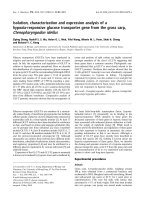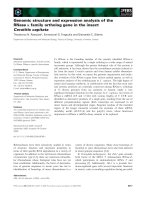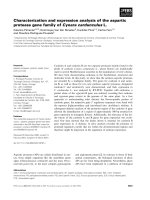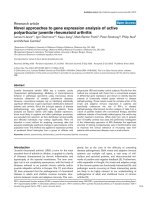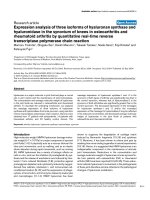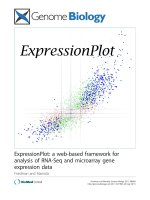Expression analysis of y TMT AND FAD2 gene in escherichia coli and transgenic trichoderma reesei
Bạn đang xem bản rút gọn của tài liệu. Xem và tải ngay bản đầy đủ của tài liệu tại đây (3.3 MB, 136 trang )
作者声明
我郑重声明:本人恪守学术道德,崇尚严谨学风。所呈交的学位论文,是本人在导
师的指导下,独立进行研究工作所取得的结果。除文中明确注明和引用的内容外,本论文
不包含任何他人已发表过或者描写过的内容。论文为本人亲自描写,并对所写内容负责。
论文作者签名:陈武海
2013 年 5 月 4 日
分类号:____________________________密级:________________________
UDC: ___________________________________________________________
华东理工大学
学位论文
-TMT 和 FAD2 基因在大肠杆菌
与里氏木霉中的表达及鉴定
陈武海
指导教师姓名:
魏东芝 教授
王 玮博士
华东理工大学上海市梅陇路 130 号
申请学位级别:
博士
专 业 名 称:
论文定稿日期:
论文答辩日期:
学位授予单位:
华东理工大学
生物化工
学位授予日期:
答辩委员会主席
评阅人
:_________________________
:_________________________
_________________________
_________________________
_________________________
EAST CHINA UNIVERSITY OF SCIENCE AND TECHNOLOGY
THESIS OF PHILOSOPHY DOCTOR
EXPRESSIONAL ANALYSIS OF -TMT AND FAD2 GENES IN
Escherichia coli AND Trichoderma reesei
Specialty
: Biochemistry Engineering
Research field
: Microbiology & Gene Technology
PhD student
: Tran Vu Hai
Student ID
: 010090147
Advisors
: Prof. PhD. Wei Dong Zhi
PhD. Wang Wei
Shanghai-China, May 4, 2013
EAST CHINA UNIVERSITY OF SCIENCE AND TECHNOLOGY- THESIS OF PHILOSOPHY DOCTOR
I
ABSTRACT
Tocopherols, with antioxidant properties, are synthesized by photosynthetic organisms and
play important roles in human and animal nutrition. In the major oilseed crops, -tocopherol, the
biosynthetic precursor to α-tocopherol, is the predominant form found in the leaves. This
suggests that the final step of the α-tocopherol biosynthetic pathway was catalyzed by γtocopherol methyltransferase.
The full-length -PfTMT was obtained from the total RNA of Perilla frutescens leaves by
RT-PCR. Sequence analysis indicates that -PfTMT consisted the open reading frame of 894
nucleotides encoding the protein of 34 kD polypeptide. Our results demonstrated that the E. Coli
BL21(DE3) expression of the -PfTMT resulted in the α-tocopherol contents (and -tocopherol
conversion yield) from 18% in the reaction products. Transgenic Trichoderma reesei Rut-C30
strains, over-expressing the γ-PfTMT was also generated by Agrobacterium tumefaciensmediated transformation. The presence of hph and γ-PfTMT gene in the transformants were
confirmed by PCR analysis. The expression of the γ-PfTMT gene of the transgenes was
demonstrated by SDS-PAGE. Furthermore, we demonstrated that the Trichoderma reesei RutC30 expression of the γ-PfTMT gene resulted in the tocopherol composition 5.9-fold increase in
α-tocopherol content by using high-performance liquid chromatographic (HPLC) method. The
increase in the α-tocopherol content indicates that a regulatory function of the γ-PfTMT protein
converts -tocopherol to α-tocopherol.
The full-length -BoTMT was obtained from the total RNA of Brassica oleracea leaves by
RT-PCR. Sequence analysis indicates that -BoTMT consisted the open reading frame of 1041
nucleotides encoding the protein of 39 kD polypeptide. Our results demonstrated that the E. Coli
BL21(DE3) expression of the -BoTMT resulted in the α-tocopherol contents (and -tocopherol
conversion yield) from 23% of the reaction products by using HPLC method. Transgenic
Trichoderma reesei Rut-C30 strains, over-expressing the γ-BoTMT gene was also generated by
Agrobacterium tumefaciens-mediated transformation. The presence of hph and γ-BoTMT gene in
the transformants were confirmed by PCR analysis. The expression of the γ-BoTMT gene of the
transgenes was demonstrated by SDS-PAGE.
Fatty acids are the main groups of components of plant membrane lipid and seed storage
lipid, and the major source of energy in plant. According to bioinformation analysis of the cDNA
II
EAST CHINA UNIVERSITY OF SCIENCE AND TECHNOLOGY- THESIS OF PHILOSOPHY DOCTOR
sequence, the specific fragment of FAD2 from immature maize embryos was isolated by RTPCR. Results of sequence analysis indicate that FAD2 fragment contains the open reading frame
of 1,236 bp long coding for the 46 kD polypeptide. Transgenic Trichoderma reesei Rut-C30
strains, over-expressing the FAD2 gene from maize were generated by Agrobacterium
tumefaciens-mediated transformation. The presence of hph and FAD2 gene in the transformants
were confirmed by polymerase chain reaction (PCR) analysis. The expression of the FAD2 gene
of the transgenes from Trichoderma reesei and E. coli BL21 were demonstrated by SDS-PAGE.
In this study, we developed novel plasmids containing three plasmids designated pBI121TMT, pCAMBIA1301S-FAD2 and pCAMBIA1301S-FAD2-TMT that incorporate modified and
improved expression omega-3 and vitamin E content in seeds of the plant transformation. The
FAD2 and -PfTMT genes of each plasmid were driven by the constitutive CaMV 35S promoter
which is mostly used for driving trangene expressions in both monocot and dicot plant
transformation. The binary vector pCAMBIA1301S-FAD2 and vector pBI121-TMT contains
FAD2, -PfTMT genes respectively, whereby the binary vector pCAMBIA1301S-FAD2-TMT
contains both FAD2 and -PfTMT gene. All three plasmid vectors were introduced into A.
tumefaciens EHA105 by electroporation.
Keywords FAD2 gene; -TMT; Perilla frustescens; Brassica oleracea; tocopherol; HPLC;
Trichoderma reesei; Agrobacterium tumefaciens
EAST CHINA UNIVERSITY OF SCIENCE AND TECHNOLOGY- THESIS OF PHILOSOPHY DOCTOR
III
CONTENTS
ABSTRACT ………………………………………………………………………………
I
CONTENTS……………………………………………………………………………….
III
LIST OF FIGURES……………………………………………………………………….
VII
LIST OF TABLE ………………………………………………………………………....
IX
NOMENCLATURE ………………………………………………………………………
X
Chapter 1. Biodiversity and phylogeny of Trichoderma ………………………………
1
1.1. Characteristics of Trichoderma spp. …………………………………………..
2
1.2. Tools for genetic manipulation of Trichoderma ………………………………
3
1.3. Defense mechanisms and their exploitation ……………………………………
4
1.4. Trichoderma’s strategies for combat …………………………………………..
4
1.5. Regulatory mechanisms triggering the defense of Trichoderma ……………..
5
1.6. Trichoderma as a protector of plant health ……………………………………
6
1.7. Secondary metabolites …………………………………………………………..
6
1.8. Trichoderma spp. as industrial workhorses ……………………………………
7
1.9. Cellulases and plant cell wall-degrading enzymes ……………………………..
7
1.10. Heterologous protein production ………………………………………………
8
1.11. Food industry ……………………………………………………………………
9
1.12. Human pathogenic species ……………………………………………………..
10
Chapter 2. Agrobacterium-mediated transformation of Trichoderma reesei
overexpressing the Perilla frutescens -tocopherol methyltransferase gene ……………
11
2.1. Introduction ………………………………………………………………………
11
2.2. Materials and methods …………………………………………………………..
11
2.2.1. Strains, plasmid, media and major reagent ……………………………………..
14
2.2.2. Primer design ……………………………………………………………………
14
2.2.3. RNA Isolation ……………………………………………………………………
14
2.2.4. Reverse Transcriptase Reactions PCR ………………………………………….
15
2.2.5. Transformation plasmid into DH5a strain of Escherichia coli ………………….
16
2.2.6. Vector construction ………………………………………………………………
17
2.2. 7. Transformation of A. tumefaciens with plasmid DNA (binary vector system) …..
17
2.2. 7.1. Preparation of competent cells ………………………………………………… 19
IV
EAST CHINA UNIVERSITY OF SCIENCE AND TECHNOLOGY- THESIS OF PHILOSOPHY DOCTOR
2.2. 7.2. Electroporation ………………………………………………………………… 19
2.2.8. Agrobacterium tumefaciens-mediated fungal transformation …………………….
19
2.2. 9. Molecular analysis of transformants …………………………………………….
20
2.2.10. Expression -PfTMT gene in Trichoderma viride ……………………………….
21
2.2.11. Expression -PfTMT gene in E. coli BL21 ………………………………………
21
2.2.12. The enzyme activity assay of the recombinant -PfTMT ………………………...
21
2.2.13. Chemical analysis ……………………………………………………………….
22
2.3. Results ……………………………………………………………………………… 22
2.3.1. Characterization of -PfTMT gene ………………………………………………..
23
2.3.2. Agrobacterium-mediated fungal transformation ………………………………….
24
2.3.3. Molecular analysis of transformants ……………………………………………... 27
2.3.4. Expression of -PfTMT in Trichoderma reesei …………………………………..
28
2.3.5. Expression of -PfTMT in E. coli ………………………………………………...
29
2.3.6. The enzyme activity assay of the recombinant -PfTMT protein …………………
30
2.4. Discussion ………………………………………………………………………….
33
2.5. Conclusion …………………………………………………………………………
35
Chapter 3. Agrobacterium-mediated transformation of Trichoderma reesei
overexpressing the Brassica oleracea γ -tocopherol methyltransferase gene ……………
36
3.1. Introduction ………………………………………………………………………
36
3.2. Materials and methods …………………………………………………………..
37
3.2.1. Strains, plasmid, media and major reagent ……………………………………..
37
3.2.2. Primer design ……………………………………………………………………
38
3.2.3. Transformation plasmid into DH5a strain of Escherichia coli …………………
38
3.2.4. Vector construction ……………………………………………………………..
38
3.2.5. Agrobacterium tumefaciens-mediated fungal transformation ………………….
40
3.2.6. Molecular analysis of transformants ……………………………………………
41
3.2. 7. Expression -BoTMT gene in Trichoderma reesei ……………………………..
41
3.2.8. Expression -BoTMT gene in E. coli BL21 ………………………………………
42
3.2.9. The enzyme activity assay of the recombinant -BoTMT ………………………..
42
3.2.10. Chemical analysis ……………………………………………………………..
42
EAST CHINA UNIVERSITY OF SCIENCE AND TECHNOLOGY- THESIS OF PHILOSOPHY DOCTOR
V
3.3. Results …………………………………………………………………………
43
3.3.1. Characterization of -BoTMT ………………………………………………….
43
3.3.2. Agrobacterium-mediated fungal transformation ……………………………….
44
3.3.3. Molecular analysis of transformants ……………………………………………
46
3.3.4. Expression of -BoTMT in Trichoderma reesei ………………………………
47
3.3.5. Expression of -BoTMT in E. coli ……………………………………………….
48
3.3.6. The enzyme activity assay of the recombinant -BoTMT protein ……………….
49
3.4. Discussion …………………………………………………………………………
49
3.5. Conclusion ………………………………………………………………………..
51
Chapter 4. Agrobacterium-mediated transformation of Trichoderma reesei
overexpressing the FAD2 gene ……………………………………………………………
52
4.1. Introduction ……………………………………………………………………….
52
4.2. Materials and methods ……………………………………………………………
55
4.2.1. Strains, plasmid, media and major reagent ………………………………………
55
4.2.2. Primer design …………………………………………………………………….
56
4.2.3. RNA Isolation, Reverse Transcriptase Reactions PCR …………………………..
56
4.2.4. Transformation plasmid into DH5a strain of Escherichia coli …………………..
56
4.2.5. Vector construction ………………………………………………………………
57
4.2.6. Agrobacterium tumefaciens-mediated fungal transformation ……………………
58
4.2.7. Molecular analysis of transformants ……………………………………………..
58
4.2.8. Expression FAD2 gene in E. coli and Trichoderma reesei ……………………….
59
4.3. Results ……………………………………………………………………………… 60
4.3.1. Characterization of maize FAD2 gene ……………………………………………
60
4.3.2. Agrobacterium-mediated fungal transformation …………………………………. 62
4.3.3. Molecular analysis of transformants ……………………………………………..
64
4.3.4. Expression of FAD2 in Trichoderma reesei ………………………………………
65
4.4. Discussion …………………………………………………………………………..
66
4.5. Conclusion ………………………………………………………………………….
67
Chapter 5. Novel plant transformation vectors containing γ-PfTMT and FAD2 genes .. 68
5.1. Introduction ………………………………………………………………………..
5.2. Materials and methods ……………………………………………………………
68
VI
EAST CHINA UNIVERSITY OF SCIENCE AND TECHNOLOGY- THESIS OF PHILOSOPHY DOCTOR
5.2.1. PCR Overlapping Extension ……………………………………………………… 70
5.2.2. Vector construction ……………………………………………………………….. 70
5.2.3. Transformation of A.tumefacient with plasmid DNA …………………………….
74
5.2.3.1. Preparation of competent cell ………………………………………………….
74
5.2.3.2. Electroporation ………………………………………………………………..
75
5.3. Results and discussion ……………………………………………………………..
75
5.3.1. PCR Overlapping Extension ……………………………………………………… 75
5.3.2. Construction of plasmid vector pCAMBIA1301S-FAD2, pCAMBIA1301S-TMT
and pCAMBIA1301S-FAD2-TMT. ………………………………………………………
77
5.3.3. Transformation of A.tumefacient with plasmid DNA ……………………………..
80
5.4. Conclusion ………………………………………………………………………….
81
Chapter 6. Conclusion and Future direction ……………………………………………..
82
6.1. Conclusion ………………………………………………………………………….
82
6.2. Future direction ……………………………………………………………………
83
REFERENCE ………………………………………………………………………………..
84
ACKNOWLEDGEMENT …………………………………………………………………..
112
AUTHOR’S INTRODUTION ………………………………………………………………
113
APPENDIX ………………………………………………………………………………….
116
EAST CHINA UNIVERSITY OF SCIENCE AND TECHNOLOGY- THESIS OF PHILOSOPHY DOCTOR
VII
LIST OF FIGURES
Fig. 1.1. Expression of DsRed2 in transformed fungi …………………………………….
5
Fig. 2.1. Chemical structures of α-, β-, γ-, and δ-tocopherols ……………………………
12
Fig. 2.2. -TMT enzymatic reaction. -TMT adds a methyl group to ring carbon 5 of tocopherol …………………………………………………………………………………..
13
Fig. 2.3. Schematic diagram of the binary vectors pPK5-PfTMT …………………………
18
Fig. 2.4. Schematic diagram of the expression vectors pET28a-TMT-Pf …………………
18
Fig. 2.5. PCR amplification of -PfTMT gene ……………………………………………..
24
Fig. 2.6. Alignment of γ-TMT protein sequences from Perilla frutescence and three other
organisms using ClustalW2 software ………………………………………………………
24
Fig. 2.7. Colony morphology of T. reesei Rut-C30 transformants on solid media ………..
25
Fig. 2.8. The plasmid pPK5-PfTMT was tested by electrophoresis ……………………….
26
Fig. 2.9. A. PCR analysis of the hph gene inserted in genomic DNA of T. reesei Rut-C30
transformation; B. PCR analysis of the -PfTMT gene inserted in genomic DNA of
T.reesei Rut-C30 transformation …………………………………………………………..
27
Fig. 2.10. Expression of the recombinant -PfTMT in T. reesei Rut-C30 ……………….
27
Fig. 2.11. Purification of His-tagged -PfTMT fusion protein ……………………………
29
Fig. 2.12. Expression of the recombina -PfTMT in E. coli ………………………………
30
Fig. 2.13. A. Separation of - and -tocopherol product standards; B. HPLC analysis of tocopherol production in T. reesei Rut-C30 untransformed control; C. HPLC analysis of
-tocopherol production for T. reesei Rut-C30 transformation ……………………………
31
Fig. 2.14. HPLC analysis of -tocopherol production in E. coli. Cells; A. Separation of and -tocopherol product standards; B. E. coli BL21(DE3)/pET30a controls; C. E. coli
BL21(DE3)/pET-PfTMT transformation …………………………………………………..
32
Fig. 3.1. Schematic diagram of the binary vectors pPK5-BoTMT ………………………… 39
Fig. 3.2. Schematic diagram of the expression vectors pET28a-TMT-Bo …………………
40
Fig. 3.3. PCR amplification of -BoTMT gene ……………………………………………..
46
Fig. 3.4. Colony morphology of T. reesei Rut-C30 transformants on solid media ………...
43
Fig. 3.5. The plasmid pPK5-BoTMT was tested by electrophoresis ……………………….
44
Fig. 3.6. PCR analysis of the hph and -BoTMT gene inserted in genomic DNA of T.
VIII
EAST CHINA UNIVERSITY OF SCIENCE AND TECHNOLOGY- THESIS OF PHILOSOPHY DOCTOR
reesei Rut-C30 transformation ……………………………………………………………... 45
Fig. 3.7. Expression of the recombinant -BoTMT in T. reesei Rut-C30 …………………..
47
Fig. 3.8. Expression of the recombinant -BoTMT in E. coli ………………………………
48
Fig. 3.9. HPLC analysis of -tocopherol production in E. coli. Cells …………………….. 49
Fig. 4.1. Schematic diagram of the binary vectors pPK5-FAD2 …………………………... 57
Fig. 4.2. Schematic diagram of the binary vectors pET-FAD2 …………………………….
58
Fig. 4.3. PCR amplification of FAD2 gene from maize genomic DNA …………………… 60
Fig. 4.4. Alignment of FAD2 protein sequences from Zea mays and four other organisms
using ClustalW2 software using ClustalW2 software ……………………………………… 61
Fig. 4.5. Colony morphology of T. reesei Rut-C30 transformants on solid media ……….. 62
Fig. 4.6. The plasmid pPK5-FAD2 was tested by electrophoresis …………………………
63
Fig. 4.7. A. PCR analysis of the hph gene inserted in genomic DNA of T. reesei Rut-C30
transformation; B. PCR analysis of the FAD2 gene inserted in genomic DNA of T. reesei
Rut-C30 transformation …………………………………………………………………….
64
Fig. 4.8. Expression of the recombinant FAD2 …………………………………………….
65
Fig. 5.1. Site directed mutagenesis using double stranded megaprimers …………………..
71
Fig. 5.2. A. The binary vectors pCAMBIA1301-FAD2; B. The binary vectors pBI121TMT; C. The binary vectors pCAMBIA1301-FAD2-TMT ………………………………..
73
Fig. 5.3. PCR amplification of -PfTMT gene from Perilla frutescens genomic DNA …..
76
Fig. 5.4. The plasmids were tested by electrophoresis ……………………………………..
78
Fig. 5.5. The plasmids were tested by restriction enzyme …………………………………
78
Fig. 5.6. The A. tumefaciens EHA105 transformed with the recombinant vector …………
80
Fig. 5.7. PCR of A. tumefaciens containing every plasmids pCAMBIA1301-FAD2,
pCAMBIA1301-TMT, and pCAMBIA1301-FAD2-TMT transformants showing presence
of FAD2, -BoTMT and -PfTMT gene. ……………………………………………………. 81
EAST CHINA UNIVERSITY OF SCIENCE AND TECHNOLOGY- THESIS OF PHILOSOPHY DOCTOR
IX
LIST OF TABLES
Table 2. Primers used in -PfTMT gene ………………………………………………….
14
Table 3. Primers used in -BoTMT gene …………………………………………………
38
Table 4. Primers used in FAD2 gene …………………………………………………….
56
Table 5. Primers used in γ-PfTMT and FAD2 gene ………………………………………
70
X
EAST CHINA UNIVERSITY OF SCIENCE AND TECHNOLOGY- THESIS OF PHILOSOPHY DOCTOR
NOMENCLATURE
-BoTMT
Brassica oleracea γ -tocopherol methyltransferase
-PfTMT
Perilla frutescens -tocopherol methyltransferase
-TMT
-tocopherol methyltransferase
A. tumefaciens
Agrobacterium tumefaciens
AMT
Agrobacterium-mediated transformation
AS
Acetosyringone
ATMT
Agrobacterium tumefaciens-mediated transformation
bp
Base pair
CaMV 35S promoter
Cauliflower mosaic virus 35S promoter
DEPC
Diethylpyrocarbonate
DNA
Deoxyribo Nucleic acid
E. coli
Escheria coli
EDTA
Ethylenediaminetetraacetic acid
FAD
Fatty acids desaturases
GUS
-glucuronidase
hph
Hygromycin phosphotransferase
HPLC
High-performance liquid chromatography
IM
Induction medium
IPTG
Isopropyl -D-1-Thiogalactopyranoside
kDa
Kilodalton
LB
Luria Bertani
MCS
Multiple cloning site
Nos-ter
Nopaline synthase terminator
OCS
Octopine synthase terminator
OD
Optical density
PCR
Polymerase chain reaction
PDA
Potato dextrose agar
REMI
Restriction enzyme mediated integration
RNA
Ribonucleic acid
EAST CHINA UNIVERSITY OF SCIENCE AND TECHNOLOGY- THESIS OF PHILOSOPHY DOCTOR
RT-PCR
Reverse transcription PCR
SAM
S-Adenosylmethionine
SDS-PAGE
Sodium dodecyl sulfate polyacrylamide gel electrophoresis
T. reesei
Trichoderma reesei
XI
1
EAST CHINA UNIVERSITY OF SCIENCE AND TECHNOLOGY-THESIS OF PHILOSOPHY DOCTOR
Chapter I
BIODIVERSITY AND PHYLOGENY OF TRICHODERMA
Trichoderma was first proposed as a genus by Persoon in 1794 [181], and several species of
Hypocrea have been linked in 1865 [248]. Nevertheless, the different species allocate to the
genus Trichoderma/Hypocrea were not easy to distinguish morphologically. It was intended to
reduce taxonomy to Trichoderma viride species. Therefore, the development of a conception for
classification was introduced until 1969 [194, 204]. After that, multiple new species of
Trichoderma/Hypocrea were observed, and the genus already consisted of more than 100
phylogenetically determined species in 2006 [54]. In some condition, misidentification of certain
species has appeared in recently reports, for Trichoderma harzianum which has been applied to
many different species [126]. Nevertheless, it is difficult to certainly correct these
misunderstanding without studying the strains originally used. Therefore, we summarized the
data using the names as originally published. In recently years, by development of an
oligonucleotide barcode (TrichOKEY) and a customized similarity search tool (TrichoBLAST)
safe classification of new species was significantly make easy [278, 53, 113]. An additional
useful tool for the new characteristic isolated Trichoderma species are phenotype microarrays,
which permit for analysis of carbon utilization patterns for 96 carbon sources [17, 119, 55]. The
prolongation application to elucidate diversity and geographical occurrence of Trichoderma/
Hypocrea follow on detailed demonstration of the genus in the world [203, 30, 95, 276].
The Index Fungorum database [277] at present lists 471 different names for Hypocrea
species and 165 records for Trichoderma. Even so, many of these names have been innovated
long before molecular methods for species classification were obtainable. They are likely to have
get
obsolete
in
the
meanwhile.
Nowadays,
the
International
Subcommission
on
Trichoderma/Hypocrea lists 104 species [279], which have been identified at the molecular
level. 72 species of Hypocrea have been characterized in temperate Europe [95]. However, a
appreciable number of putative Hypocrea strains and Trichoderma strains, for which sequences
have been saved in GenBank, are still without safe characterization [54]. Species of the genus get
a broad array of pigments from brightly greenish yellow to reddish, even though some of them
are also colorless. Likewise, conidial pigmentation varies from colorless to severally green
shades and even also gray or brown. Other species of pigments classification within the genus is
2
EAST CHINA UNIVERSITY OF SCIENCE AND TECHNOLOGY- THESIS OF PHILOSOPHY DOCTOR
not easy because of the narrow class of modification of the uncomplicated morphology in
Trichoderma [71].
1.1. Characteristics of Trichoderma spp.
Trichoderma spp. are universal colonizers of cellulosic materials and can thus frequently be
create wherever decaying plant material is availability [121, 95] besides in the rhizosphere of
plants, where they can induce systemic resistance opposed pathogens [82]. The searching for
potent biomass degrading enzymes and organisms also run to insulation of these fungi from
unexpected material, example of cockroaches [267], marine mussels and shellfish [200, 199], or
termite guts [230]. Trichoderma spp. are identified by quick growth, mainly bright green conidia
[71].
In spite of the early indicated connection between Trichoderma and Hypocrea [248], this
anamorph teleomorph correlation of Trichoderma reesei and Hypocrea jecorina was only
demonstrated more than 100 years later [125]. However, because all attempts to cross the
attainable strains of this species had unsuccessful, T. reesei was then named a clonally, asexual
derivative of H. jecorina. Trichoderma species brought more than ten up to a sexual cycle was
published [217]. The further studies on molecular evolution of this species go to the finding of a
detail sympatric agamospecies Trichoderma parareesei [51]. First of all, the industrial
consideration of T. reesei, the usefulness of a sexual cycle was a groundbreaking finding and
paves the way for elucidation of sexual growing in other members of the genus now.
Trichoderma spp. are greatly successful colonizers of their habitats. It is presented both by
their efficient utilization of the substrate at hand and their emission ability for enzymes and
antibiotic metabolites. They are know-how deal with such other environments as the dark and the
fermentation bioprocess fermentor or shake flask besides the rich and diversified of tropical
rainforest ecology. Therefore, they react to their environment by regulation of growth,
conidiation, enzyme production, and so adapt their lifestyle to present conditions such as light.
Trichoderma has for a long duration of studying about the light effection on its physiology and
evolution from 1957 and much paralleled which of Phycomyces blakesleeanus [207]. In addition,
growth conidiation, enzyme production, and secondary metabolite biosynthesis, the cellulase
gene expression has affected in fungi [207]. By a study on carbon source utilization using
phenotype microarrays in different condition of light, the direct connection between light
responsive and metabolic processes was advanced supported [67]. The research about the light
EAST CHINA UNIVERSITY OF SCIENCE AND TECHNOLOGY-THESIS OF PHILOSOPHY DOCTOR
3
affection for the molecular basis discovered interconnections between the signaling pathways of
light response, heterotrimeric G-proteins, the cAMP pathway, sulfur metabolism, and oxidative
stress are operative in Trichoderma [207, 241].
In recently years, studying with Trichoderma has been promoted importantly by genomes
sequencing of three strains representing the most crucially applications of this genus: The
genome sequence of T. reesei [147, 274], besides that, in spite of its significance in industrial
cellulase production, its genome contain the fewest many genes encoding cellulolytic and
hemicellulolytic enzymes. Analysis and explanation for genomes of two important biocontrol
species as Trichoderma atroviride and Trichoderma virens [275] is still in research now. As the
result, the genomes of two important species are significantly better than that of T. reesei, they
comprise roughly 2000 genes. This substantial difference in genome sizes in the physiology of
these fungi will be interesting on research. Further studies are milestones for Trichoderma,
which provided intriguing insights into their lifestyle, physiology, and adaptive evolution at the
molecular level [25, 147, 212, 133, 218].
1.2. Tools for genetic manipulation of Trichoderma
Because of the industrial application of T. reesei, the developmental genetic toolkit for this
fungus is the great expansion of the genus, although also studying with other species is unlimited
by technical obstacles and most tools can also be used for all species with slight transformation.
Modification of many species is acceptable, and different advance such as protoplasting [75],
transformation of Agrobacterium-mediated [271], or transformation of biolistic [139] were
applied. The range of selectable marker cassettes such as hygromycin [142] and benomyl
resistance [182, 213], the Aspergillus nidulans amdS gene, which possible growth on acetamide
as sole nitrogen matterial [178] besides the auxotrophic markers, pyr4 [75], arg2 [10], and hxk1
[79] accept of multiple modification construction, which is now facilitated by the available of a
T. reesei strain with perturbed nonhomologous endjoining pathway [78]. Sequential gene
deletions despite a restriction number of selectable markers became able to by the use of a blaster
cassette comprising direct repeats for homologous recombination and excision of the marker
gene selection [84]. Besides knockout strategies for functional analysis of transgenic, also
through over-expression or antisense knockdown [195, 156, 211] was studied for Trichoderma,
and RNAi has been expressed to function in T. reesei [18]. The results indicated that, a sexual
cycle in T. reesei [217] more boosts the adaptability of T. reesei was applied both industrial and
4
EAST CHINA UNIVERSITY OF SCIENCE AND TECHNOLOGY- THESIS OF PHILOSOPHY DOCTOR
basic research.
1.3. Defense mechanisms and their exploitation
Fortunate colonization of a given habitat by any organism is crucially dependent on its
capability to defend its ecological niche and to thrive and prosper in spite of contention for light,
space, and nutrients in many fungi. In particular, Trichoderma is masters of this competition [89,
83, 255]. Their defense reaction comprised enzymatic, as well as chemical weapons, which make
Trichoderma spp. efficient mycoparasites, antagonists, and biocontrol agent specific that can be
taken advantage by using Trichoderma spp. or the metabolites secreted by these fungi as
biological control of plant disease caused by pathogenic fungi [229, 254, 253, 166]. By that,
Trichoderma spp. plays a very important factor role in the three way fundamental interaction
both the plant and the pathogen [140, 262].
1.4. Trichoderma’s strategies for combat
After discovering of Trichoderma lignorum (later found to be T. atroviride) in 1932 [259],
studying on antagonistic properties of Trichoderma spp. progressed quickly. At present, the most
essential species in this field are T. atroviride, T. harzianum, T. virens, and Trichoderma
asperellum [13], hence T. reesei can a little seen as a model organism used because of the
determined molecular biological methods and available recombinant strains [216]. Trichoderma
spp. are possible control ascomycetes, basidiomycetes, and oomycetes [155, 13], and have
recently been reported [42, 129, 72]. In my laboratory, our team used the DsRed2 gene as a
reporter to test the applicability of the newly constructed vectors in T. reesei. We constructed
expression vectors pWEF31-red by insertion of the DsRed2 gene. The vectors were introduced
into T. reesei by Agrobacterium-mediated transformation. Positive transformants, F1 (pWEF31red transformation) was selected and then screened for further observation of DsRed2 expression
in both the conidia and mycelia under a fluorescence microscope (Fig. 1.1). The results indicated
that both vectors were capable of expressing an exogenous gene in fungi.
In their defensive actions, Trichoderma spp. produce a range of hydrolytic enzymes [123,
257], proteolytic enzymes [116, 235, 31], ABC transporter membrane pumps in the interaction
with different plant-pathogenic fungi [198], diffusible or volatile metabolites [29, 62], and other
secondary metabolites [190] as active measures against their hosts or they succeed by their
impairing growth conditions of pathogens [13]. Interestingly, the accomplishment of these
actions is not only independent of the surrounding temperature [162], but also crucial for the use
EAST CHINA UNIVERSITY OF SCIENCE AND TECHNOLOGY-THESIS OF PHILOSOPHY DOCTOR
5
as a biocontrol agent in climate change. Large scale researches on a functional gene product
during biocontrol at least in part represent these discovering [74, 146, 202] and reveal
supplemental components with potential effectivity such as a superoxide dismutase [74] and
amino acid oxidase [247]. Furthermore, the response of Trichoderma to its host has also been
explained to include stress response, nitrogen shortage response, cross pathway control, lipid
metabolism, and signaling proceeding [218].
Fig. 1.1. Expression of DsRed2 in transformed fungi. DsRed2 was observed in the mycelia and
conidia of T. reesei transformed with the binary expression vector pWEF31-red. The hygromycin
resistant transformants were subcultured and observed under a fluorescence microscope Olympus
BX50 [Unpublished studies of my group].
1.5. Regulatory mechanisms triggering the defense of Trichoderma
Signal transduction pathways triggering the genes were included in biocontrol and
mycoparasitism have been applied in appreciable depth and include heterotrimeric G-protein
signaling, mitogen activated protein kinase (MAPK) cascades, and the cAMP pathway [269].
Especially the MAP-kinase TVK1, characterized in T. virens [148, 161, 149] both its orthologs
in T. asperellum [274] and T. atroviride [192], is important in regulation mechanisms and
signaling pathways of active biocontrol. Transcript levels of the specific genes rised on
symbiotic interaction with plant roots in T. virens and T. asperellum [274]. T. reesei TMK1
deletion caused decreased mycoparasitic activity and advanced protection against Rhizoctonia
solani [192]. Moreover, lack of T. virens TVK1 extensively raises effective fungal biological
control agents [148].
According to the activity of the pathway of heterotrimeric G-protein signaling, two genes
6
EAST CHINA UNIVERSITY OF SCIENCE AND TECHNOLOGY- THESIS OF PHILOSOPHY DOCTOR
have been found out with a show to biocontrol mechanisms relation in Trichoderma spp.: the
class I (adenylate cyclase inhibiting) G-alpha subunits TGA1 of T. atroviride and TgaA of T.
virens both the class III (adenylate cyclase activating) G-alpha subunits TGA3 of T. atroviride
and GNA3 of T. reesei. TGA1 plays an important role in regulation of coiling around host
hyphae and regulates production of antifungal metabolites. TGA1deficiency follows on
enhanced growth inhibition of the host fungi [195, 191]. Such as TgaA, a host specific shown
incase of the activity of MAP kinases has been studied [160]. Besides that, TGA3 was all
important for biological control since deletion of the corresponding gene of the avirulent strains
[270]. Carrying constitutive activation of GNA3 in T. reesei is recommended to positively affect
by species of mycoparasitism [243]. With analysis of cAMP signaling components, the report
also indicated a positive role of cAMP in biological control [158]. Moreover, significantly role in
biological control of T. virens was studied for the homolog of the VELVET protein, which called
light dependent regulator protein [159].
In the past, we could be done distinguish effective from non efficient biological control
strains isolated from nature to know characteristics between these genes and enzymes regulation
interaction of Trichoderma with a pathogen [243, 206].
1.6. Trichoderma as a protector of plant health
The advantage of Trichoderma spp. is unlimited to fighting against pathogens; they have also
been demonstrated to be opportunistic plant symbionts, induced systemic resistance of plants
[266, 222], an answer which is enhancing by ceratoplatanin family proteins [50, 218].
Conception of the signals transmitted by Trichoderma in the plant demand for the important role
both a MAPK [221] the fungus itself, a MAPK signaling is crucial for full establishment of
systemic response in the plant [256]. By colonizing plant roots, which is not only important
improved by swollenin [19], but also their accomplished through soil and occupy new niches.
This interaction with plants besides their rhizosphere competence as biological control agents of
microbial plant pathogens result increased root proliferation, growing, and protection for the
plants against toxic chemicals and Trichoderma spp. as a remarkable resistance. Consequently,
Trichoderma spp. is hope agent to apply for remediation of polluted natural by treatment of
appropriate plants with spores [81].
1.7. Secondary metabolites
Fungi was applied as well as enzymatic weapons and potent arsenal for chemical warfare at
EAST CHINA UNIVERSITY OF SCIENCE AND TECHNOLOGY-THESIS OF PHILOSOPHY DOCTOR
7
their disposal [255]. Therefore, both potential antibiotics (for example the peptaibols) and
mycotoxins and more than 100 metabolites with antibiotic activity together with polyketides,
pyrones, terpenes, metabolites obtained from amino acids, and polypeptides [226] were
identified in Trichoderma spp. A large variety of peptaibols was discovering in Trichoderma
thereafter [47, 48, 49, 233]. Nevertheless, the development of peptaibol creation seems to be too
complex to admit for anticipation of peptaibol production profiles form phylogenetic
relationships [44, 122, 167, 49]. One of the first characterized secondary metabolites of
Trichoderma spp. was the peptide antibiotic paracelsin [23, 22]. Interestingly, the four
trichothecene mycotoxin producing species (Trichoderma brevicompactum, Trichoderma
arundinaceum, Trichoderma turrialbense, and Trichoderma protrudens) are not nearly
correlated to those species used in biological control. The application of biological control in
agriculture pose a risk and these mycotoxins play a main role in the protection mechanisms of
these fungi [170, 49]. Recently, like many other fungi, Trichoderma spp. had been reported to
out put a broad array of volatile organic mixing, which have taken more attention [233].
Effective production of peptaibols predominantly happen in solid cultivation and correlates with
conidiation [122, 241]. Signaling molecules contained rank from the blue light photoreceptors
BLR1 and BLR2 to the G-alpha subunits GNA3 (TGA3) and GNA1 as well as protein kinase A
[192, 112]. Therefore, GNA3 is all important for peptaibol production besides that stimulant of
peptaibol production in the non-appearance of BLR1 and BLR2 is still able to [112].
1.8. Trichoderma spp. as industrial workhorses
The US army was discovered T. viride QM6a in World War II [189], later on, the excellent
efficiency of its cellulases led to prolonged research toward industrial enzyme applications. After
that, this species was assigned a new name T. reesei in honor of Elwyn T. Reese [224] and
became well-know the cellulase producer worldwide until now.
1.9. Cellulases and plant cell wall-degrading enzymes
Higher energy costs and the global climate change are due to an increased attention to biofuel
production [208, 197]. Nowadays, research with T. reesei is especially approaches in
improvement of a role of the enzyme cocktail produced so that decrease all in all price of
production of bioethanol from cellulosic waste source [127] such as applications in the pulp,
paper industry [28] and textile industry [69]. After the early mutation programs [61] and strain
development, the protein emission capacity of industrial strains now reaches very high. High
8
EAST CHINA UNIVERSITY OF SCIENCE AND TECHNOLOGY- THESIS OF PHILOSOPHY DOCTOR
levels of cellulase and hemicellulase by using in the synthesis of a functional gene product can
be achieved upon cultivation on cellulose, xylan, or a mixture of plant polymers [143] and on
lactose [214], all of which use of industrial byproducts in agricultural. The natural persuader of
at least a subset of these enzymes is accepted to be sophorose, a transglycosylation output of
cellobiose [231]. Targeted arrangements to be further better the efficiency of the enzymes
secreted to include elucidation of regulatory mechanisms both at the promoter level [143, 210]
and with respect to signal transduction [207]. Nevertheless, auxiliary components acting on the
substrate could raise efficiency of its degeneration [201, 209].
In recent years, metabolic engineering has been applied successfully for contributed
intriguing insights into these processes [124], and investigation of the genome sequence of T.
reesei showed that this industrial workhorse possesses the smallest number genes within
Sordariomycetes encoding the enzymes which made it so common plant cell wall-degrading
enzymes [66, 147]. Utility of the genome sequence spurred genome full analysis of quickly
modification strains and discovery of putatively beneficial mutations, which caused their high
efficiency [133]. As the result, it seems that even early for modification such as Rut-C30 bear
considerable alterations of T. reesei genome [215]. These new tools also facilitated
characterization of the enzyme cock-tails run off by these strains [88]. In supplementation to
these effort’s enzyme technology approaches [11], improvement of the secretion machinery [37,
118] and screening of the enormous variety of plant cell wall degrading enzymes from nature
isolates [120] or other organisms secreting cellulases [45] and directed evolution [165]
complement the optimisation of the regulative mechanism of available production strains. Today,
87% of energy consumed in the world comes from oil, coal or natural gas, the contaminating
sources [151]. Thus, with the help of Trichoderma, economic reasonable production of 2nd
generation biofuels from waste products is an efficient method.
1.10. Heterologous protein production
Filamentous fungi are versatile cell factories and often applied heterologous protein
expression [1], especially if they have generally regarded as safe status [169], as has T. reesei
[168]. The manufactured in the production of calf chymosin use of T. reesei as a producer of
heterologous proteins begins more than 20 years ago [80, 249]. At that time, the expression of
immunologically active antibody fragments [172] in T. reesei was achieved, and numerous
enzymes and expression proteins followed. Currently, T. reesei is one of the most successful
EAST CHINA UNIVERSITY OF SCIENCE AND TECHNOLOGY-THESIS OF PHILOSOPHY DOCTOR
9
used filamentous fungi for production of heterologous proteins [179, 169].
Based on the efficient expression and the considerable information on regulation of cellulase
genes, their promotors are routime used for heterologous protein production [179, 210]. As a
result, developments in cellulase transcription are also advantages for these applications.
However, also alternative promotors were also shown to be helpful for certain applications [105].
In general, the high efficiency and the inducibility of the cellulase promotors have proven useful
in many applications. Apply the cellulase promotors, also relatively cheap carbon sources such
as cellulose or lactose can be used for production. In spite of that, it had to consider that the large
amount of enzymes secreted to the culture medium may be an issue in special purification of the
heterologous protein, and the complex substrates used could induce extracellular proteases,
which are deleterious for the yield of the process [105]. For complementary improvement,
promotor mutations, for example with the chb1 promotor [138], can extend yields of the protein
to be expressed.
1.11. Food industry
With their extended history of good industry for scale enzyme production, Trichoderma spp.
has also been extensively used for production of food additives and related products [168, 16].
Nowadays, several Trichoderma enzymes are used to advance the brewing proceeding,
macerating enzymes in fruit juice production, feed additive in farm animal and for pet food.
Cellulases are mainly applied in baking, malting, and grain alcohol production [70].
Nevertheless, both enzymes and metabolites of Trichoderma spp. are applied as additives. The
beginning productions isolated from T. viride was a chemical with representative coconut like
aroma, a 6-pentyl-α-pyrone [35, 173]. An interesting ideal is the procedure of cell wall degrading
enzymes, for example of T. harzianum, it is food preservatives and lost broad application
because of their antifungal effect [68]. With a likewise aim, T. harzianum mutanase can be
applied in toothpaste to avoid accumulation of mutant in dental plaque [260].
1.12. Human pathogenic species
Recent information suggests that fungi has function applied pathogenic as Candida,
Aspergillus, or Crypotcoccus, also the genus Trichoderma comprises opportunism human
pathogenic germ, which poses a dangerous and usually lethal threat, especially to HIV infected
persons and other immunocom intended patients. Belonging to the emerging fungal pathogens,
these fungi are usually not understood or diagnosed in a stadium when efficient treatment is

